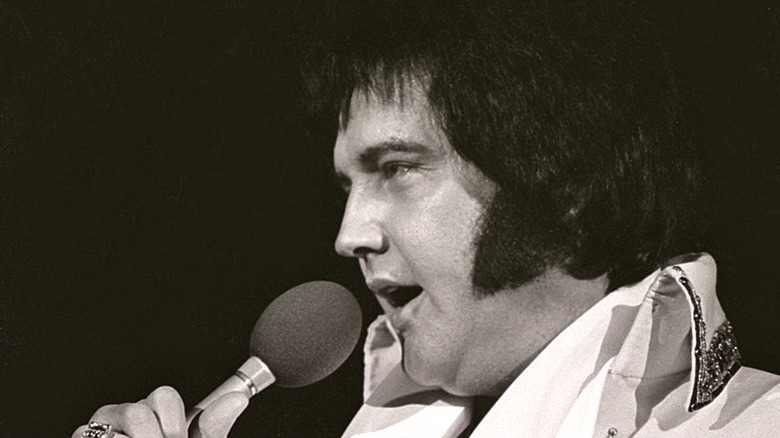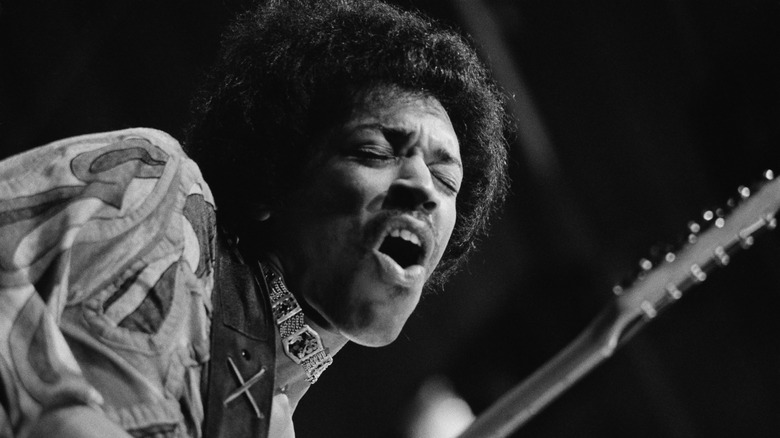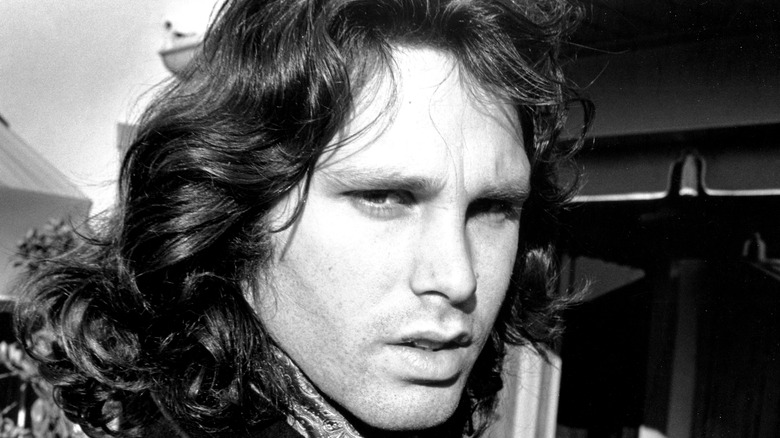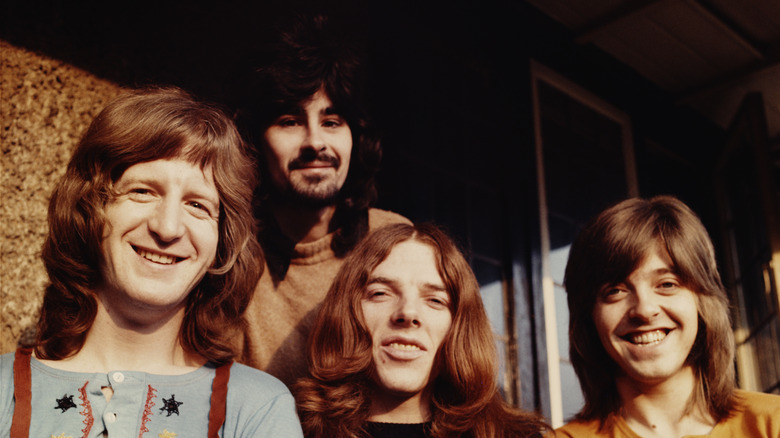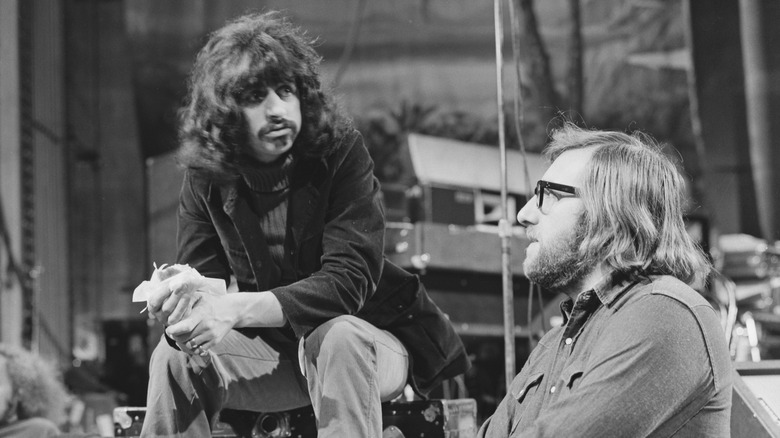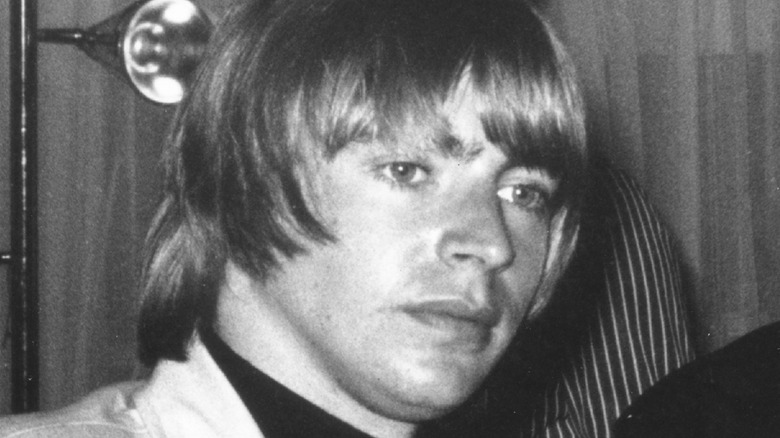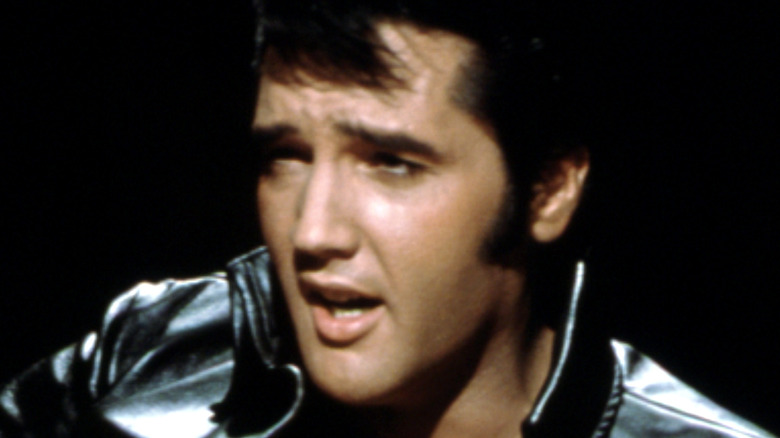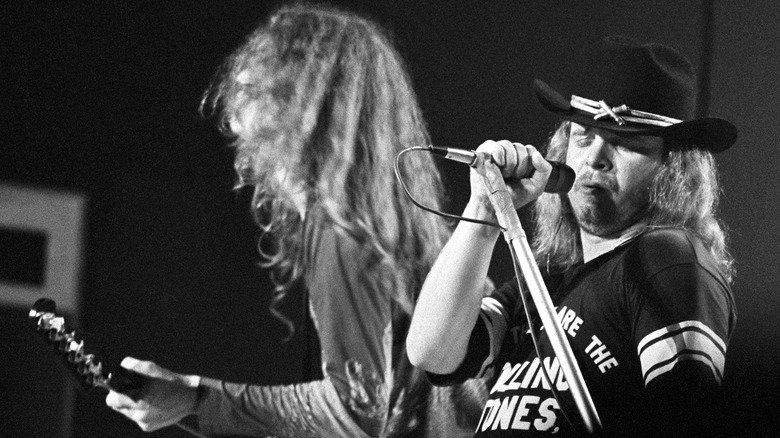The Biggest Rock And Roll Tragedies Of The 1970s Explained
Anything that has an element of glamour is sure to have an element of tragedy, and few things are more glamorous than rock and roll. From the moment the first rockers crawled out of the ocean to blow away the crowd at some prehistoric music festival (we're pretty sure that's how it happened), the genre's "live fast and die young" aesthetic has enchanted fans — but all too often, the second part of that equation has robbed the world of some pretty great artists in their prime.
Even fans themselves haven't been spared injury or death in their adulation of rock gods; just ask any festival-goer who has ever found themselves trapped in a sea of oblivious humanity, squeezed in from all sides as the music blares on. Rock is rebellious, rock is aggressive, and the '70s were rock's decade. A decade, therefore, in which it seemed more often than not, the Grim Reaper was waiting patiently, just offstage, for the lights to go down. Here are the biggest rock and roll tragedies of the 1970s, explained.
The death of Jimi Hendrix is as mysterious as it was shocking
Most casual fans know at least two things about Jimi Hendrix: That he was probably the greatest rock guitarist of all time, and that he died at the young age of 27 when he aspirated vomit in his sleep following an overdose. While both of those things are likely true, the circumstances of his death have been disputed to a far greater degree than one might think. What is known: Hendrix was found unresponsive in the hotel room he shared with a girlfriend, Monika Dannemann, on September 18, 1970, having overdosed on a titanic amount of sleeping medication. Virtually every other detail has at least one question mark attached.
For example, Hendrix's friend Eric Burdon of the Animals insists Hendrix committed suicide, having found a poem he says constituted a suicide note. Dannemann disputed this. For her part, the timeline of events that morning continually shifted in her conversations with the police. Burdon also claimed alternately to have gotten there in time to remove drugs from the scene, or that he arrived as the ambulance ferrying Hendrix to the hospital was departing. Suspicion also fell on Hendrix's mob-connected manager Michael Jeffery, who was in debt to some shady types at the time. The events surrounding the musician's death were so muddled that an inquest launched later in 1970 failed to pinpoint a conclusive cause of death — and in 1993, an attempt to open a new inquiry never even got off the ground.
If you or anyone you know is having suicidal thoughts, please call the National Suicide Prevention Lifeline by dialing 988 or by calling 1-800-273-TALK (8255).
Jim Morrison's death was shrouded in shady circumstances
Doors front man Jim Morrison was legendarily troubled in his final years. He was facing jail time for a drunken act of indecent exposure when he died in the bathtub of a Paris apartment in the company of his girlfriend Pamela Courson on July 3, 1971. That's the official line, but the shadiness surrounding the singer's death is layers deep. At the center of it all is Courson, who took some highly questionable actions after his death.
At about six in the morning, Courson found Morrison unresponsive in the tub and called the fire department and police. They packed Morrison's body in dry ice, and it remained in the apartment for three days. During that time, a physician visited, proclaimed the cause of death as heart failure, and signed a death certificate — but nobody knows who the doctor was, as his signature couldn't be made out. Courson claimed not to remember his name, and no autopsy was performed. Finally, a cheap coffin arrived, Morrison was buried in the presence of a handful of people, and that was it.
Multiple people claim to have seen Morrison in multiple locations the night before his death, with some swearing he died in the bathroom of a nightclub before being transported to the hotel. Doors keyboardist Ray Manzarek doesn't rule out the possibility that Morrison faked his own death, telling Performing Songwriter the coffin could have been filled with "150 pounds of f***ing sand."
The Allman Brothers Band lost two members in two separate motorcycle accidents
Jacksonville, Florida's Allman Brothers Band, led by (you guessed it) brothers Gregg and Duane Allman, cast a long shadow of influence over not just fellow Southern-fried rockers like Lynyrd Skynyrd, but over the rock world in general. The band's unique rhythm section configuration (consisting of two drummers and ace bassist Berry Oakley) and the guitar skills of Duane Allman were an excellent complement to Gregg's soulful, blues-inspired songwriting and keyboards, and their tendency to stretch live jams to 40 minutes or more extended their influence to bands like the Grateful Dead and their contemporaries.
Unfortunately, twin tragedies almost exactly a year apart altered the band's lineup and trajectory radically. In October 1971, Duane Allman died after swerving to avoid crashing his motorcycle into an errant pickup truck, flipping the bike several times. He was only 24 years old. The grieving band eventually regrouped to record their breakthrough studio album, 1972's "Eat a Peach" — but Oakley never quite recovered from the loss of his friend. Band associate Joseph "Red Dog" Campbell told Rolling Stone that "When Duane died, Berry died. He loved and idolized Duane. For quite a few months, that's all he thought about." In November 1972, Oakley's motorcycle collided with a bus just blocks from the site of Allman's crash, and Oakley died of a massive concussion — also at 24.
The band that should have been the next Beatles ended in tragedy
Welsh outfit Badfinger might have been remembered as one of the biggest bands ever because of two factors: the songwriting prowess of guitarist and vocalist Pete Ham and bassist Tom Evans, and their association with the Beatles. While still known as the Iveys, the band was attracting attention from several record labels when they were brought in to audition for the Fab Four's Apple Records by their road manager, Mal Evans. Their songwriting talents perked up the ears of Paul McCartney, and after hard lobbying from Evans and Apple head of A&R Peter Asher, all four Beatles agreed to sign the group.
Badfinger enjoyed success in the early '70s with such hits as the McCartney-penned "Come and Get It" and Ham and Tom Evans' "Without You," a stunningly crafted tune that went on to become among the most-covered of all time. But by the middle of the decade, gross mismanagement by business manager Stan Polley and an ill-timed label switch left the band in a financially precarious situation. In 1975, with a baby on the way and struggling to pay his bills, Ham died by suicide in the garage of his home. Tom Evans, his musical soulmate and best friend, tragically died by the same fate in 1983.
If you or anyone you know is having suicidal thoughts, please call the National Suicide Prevention Lifeline by dialing 988 or by calling 1-800-273-TALK (8255).
'Sixth Beatle' Mal Evans died because of a terrible misunderstanding
If you've ever noticed a shaggy-haired, often bearded guy with glasses hanging around in the margins in archival photos or films of the Beatles, it's almost certainly Mal Evans. The Fab Four's former road manager became an assistant and go-to guy after the band quit performing live and often provided such miscellanea as additional vocals (as in the chorus of "Yellow Submarine") or additional instrumentation (like the hand claps on "Birthday") on their recordings.
Evans dabbled in record production after the Beatles disbanded, and was in the long process of writing a memoir about his time with the band when tragedy struck. Despondent over a recent divorce, Evans responded poorly when a girlfriend called the police on him to report that he was on drugs and playing with a gun. When the cops arrived, Evans refused to drop the weapon — which turned out to be a harmless air rifle — and they shot him dead. Some of his personal effects have surfaced in recent years as highly prized collectors' memorabilia, such as John Lennon's handwritten lyrics to "A Day in the Life," which sold at auction for over $1 million in 2010.
An original member of the Yardbirds died in a freak accident
After beginning life as part of London's Blues and R&B scene in the early '60s, the Yardbirds grew to become one of the most experimental and influential British bands of the decade. Their recorded output was relatively slight, but singles like "For Your Love" and "Heart Full of Soul" had a towering influence on the band's contemporaries, and the outfit was nothing less than a breeding ground for legendary guitarists. Their second lead axe man, Eric Clapton, was replaced by Jeff Beck; he was soon joined by Jimmy Page, giving this iteration of the band arguably the most jaw-dropping twin-lead attack in history.
The band's vocalist Keith Relf dabbled in guitar himself, and long after their 1968 disbandment, Relf fell victim to one of the most freakish accidents in the annals of rock. Relf was jamming on an electric in his basement one day in May 1976 when he made the mistake of standing on a gas pipe running along the floor. His instrument was ungrounded, and Relf suffered an electric shock that killed him instantly. Although his life ended far too soon, the legacy of his band lived on, and he was posthumously inducted into the Rock and Roll Hall of Fame with the Yardbirds in 1992.
The King is dead, long live the King
Elvis Presley needs no introduction; he was the King, ruling over rock 'n roll and popular music in general in a way that few artists have approached before or since. Only Mariah Carey and the Beatles have notched more No. 1 hits, and Presley was also a multimedia star when those were exceedingly rare, appearing in 31 films between 1956 and 1969. Most fans know the basics of his passing: Presley died of heart failure at the age of 42 on August 16, 1977, with prescription drug abuse being a contributing factor. What many do not know, however, is that Presley came by all those drugs legally, through his personal physician Dr. George Nichopoulos. And Nichopoulos got himself into considerably hot water as a result.
Nichopoulos had his medical license suspended for three months in 1980 for overprescribing drugs to patients including Presley and rocker Jerry Lee Lewis. He narrowly avoided conviction on felony charges of negligently prescribing drugs to Presley specifically in 1981. Nichopoulos managed to hold onto his license until 1995 when it was permanently revoked by the Tennessee Board of Medical Examiners. Board member Dr. Edgar Scott told AP News, "[Nichopoulos] himself agreed that some of his patients were addicts, yet he gave them their drug of choice ... That's certainly unethical."
If you or anyone you know needs help with addiction issues, help is available. Visit the Substance Abuse and Mental Health Services Administration website or contact SAMHSA's National Helpline at 1-800-662-HELP (4357).
A monster band ends its run with the loss of its front man
While they never made a ton of noise stateside, British outfit T. Rex made plenty of it in the U.K. during the glam rock era. Led by swaggering, smoldering lead singer Marc Bolan, the band scored ten straight Top Ten hits in their native country in the early '70s, with one of those — "(Bang a Gong) Get It On," which was later covered by '80s supergroup The Power Station — cracking the American Top Ten. By later in the decade, their commercial fortunes had waned, and in 1977, any chance of a resurgence came to an abrupt halt — literally.
In September of that year, Bolan was a passenger in a car driven by his girlfriend, singer Gloria Jones, when Jones lost control and careened off the road. Bolan was killed in the ensuing accident. For years, it was thought that the car had hit a sycamore tree, resulting in Bolan being crushed. In 2012, however, singer Vicky Aram, whose car had been following Bolan's that night, spoke to the Independent in the interest of setting the record straight. The vehicle had in fact collided with a steel-reinforced fence post, and Bolan had suffered a massive head injury. The sycamore tree had actually prevented the vehicle from plunging down an embankment, which likely would have caused Jones' death, as well.
A Southern Rock giant felled
Lynyrd Skynyrd rose to virtually define Southern rock in the '70s, and it took the band only two tries to achieve a multi-platinum record, with 1974's "Second Helping" and its iconic hit single "Sweet Home Alabama." The countrified, bluesy band's main strengths were the gravelly voice and strong songwriting of frontman Ronnie Van Zant and the guitar virtuosity of Steve Gaines — which made the tragedy that befell the outfit in 1977 all the crueler.
As their touring schedule ramped up, the band decided to charter a private plane, and its manager settled on a Convair 240 that had recently been looked over — and rejected — by fellow rockers Aerosmith. En route from Greenville, South Carolina to a gig in Baton Rouge, Louisiana, the plane ran out of fuel, crashing in a thick stretch of woods in Mississippi. While 20 passengers survived, six did not, including both pilots, a road manager, Van Zant, Gaines, and his sister, backup singer Cassie Gaines. The band has continued on with various lineups in the intervening years, but only their 2008 Greatest Hits album has approached the chart success of their early work.
Chicago lost a key member to a senseless tragedy
Chicago was a bit of an outlier in the world of '70s rock, boasting an expansive, horn-driven sound and a facility for hard-hitting, funky rock as well as sweet, tender ballads. Guitarist Terry Kath may have gotten lost in the mix a little bit amongst all those horns, but it certainly wasn't for lack of talent — such guitar gods as Jimi Hendrix, Joe Walsh, and Toto's Steve Lukather were huge fans, and he may today be recognized as an all-time great guitarist if not for a horrifying accident in January 1978.
A gun enthusiast, Kath was cleaning a firearm at the home of band employee Don Johnson, who became a bit wary of the situation. Kath demonstrated to Johnson that the clip was empty, subsequently pulling the trigger — on a round that had been left in the chamber. Kath was shot in the head and died immediately. Kath's daughter Michelle Kath Sinclair produced a documentary on her father in 2017, in which (via Rolling Stone) Walsh stated, "All we have to go on are the records he's made ... and his guitar work is long forgotten. And that's a shame, because he was a complete monster."
Death of a wild man
The Who's drummer Keith Moon was a legendary lunatic, prankster, drunk, and drug abuser who was prone to such stunts as utterly trashing hotel rooms, throwing televisions out of windows, and driving cars into hotel swimming pools. He had leveled off by 1978, cutting back on booze and planning to marry his then-girlfriend Annette Walter-Lax. Unfortunately, he was also becoming dependent on Heminevrin, the powerful sedative that was helping him to kick alcohol, and on September 7, 1978, that dependency had fatal consequences.
After attending a film premiere the previous evening, Moon and Walter-Lax retired to their flat, watched a movie, had a little to eat, and went to bed, Moon having taken a number of Heminevrin pills. Moon woke up around 7 a.m., ate some more, took some more pills, returned to bed — and never woke up. Walter-Lax found him unresponsive that afternoon, and after Moon was pronounced dead at a local hospital, he was found to have 26 Heminevrin pills still undigested in his stomach.
If you or anyone you know needs help with addiction issues, help is available. Visit the Substance Abuse and Mental Health Services Administration website or contact SAMHSA's National Helpline at 1-800-662-HELP (4357).
The Riverfront Coliseum disaster
The Who were still regrouping from the death of their drummer in late 1979 when they played a fateful gig at Riverfront Coliseum in Cincinnati, Ohio — one that prompted a strenuous reevaluation of the way concert seating is handled. The event featured what was known as "festival seating," a first-come-first-serve type of general admission which had already been under scrutiny in the U.S. On December 3, 1979, thousands of fans awaiting admission to the show surged forward when the doors opened, hoping to secure prime positions on the floor. In the stampede, 11 people were killed — and yet, the show went on, with the band not informed of what happened until after it was over.
The City of Cincinnati banned festival seating in the aftermath of the stampede, although the practice has made a comeback in recent years. In a 2022 Rolling Stone retrospective on the Who concert disaster, concertgoer Gerry Craven described the terror he felt in the crush. "You don't expect to fight for your life at a Who concert," he said. "It was kind of like hell. ... There was nothing we could do to get out of it." That year, the Who returned to Cincinnati for the first time since the disaster, offering a measure of closure for those who still remember.
